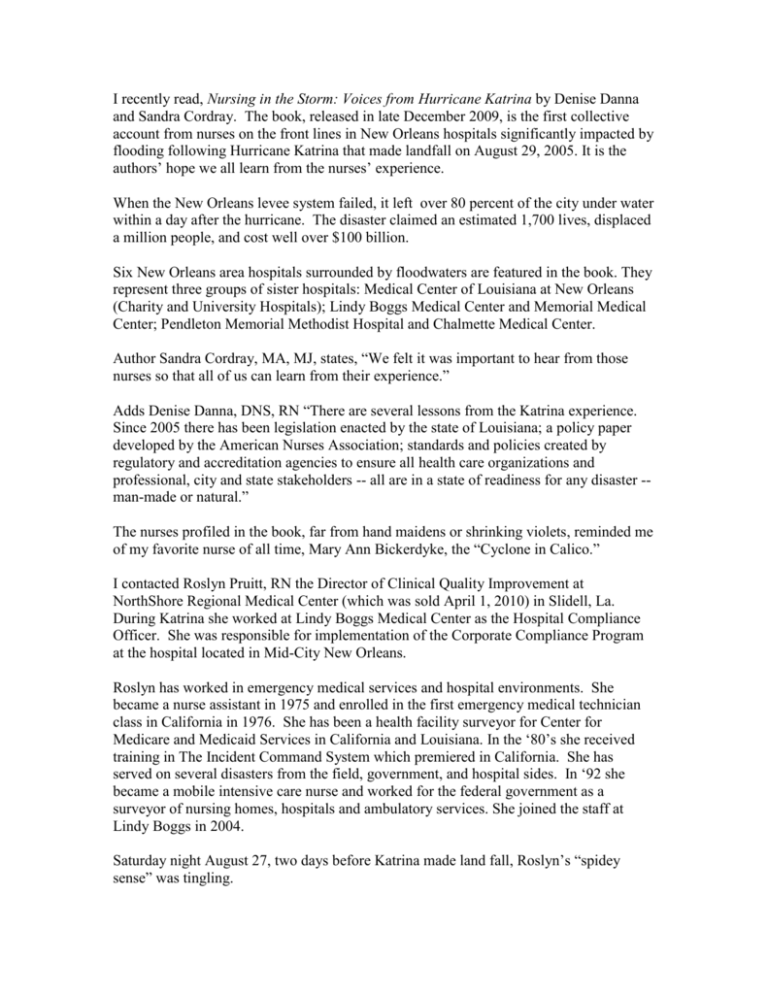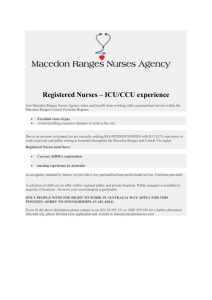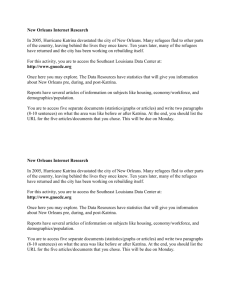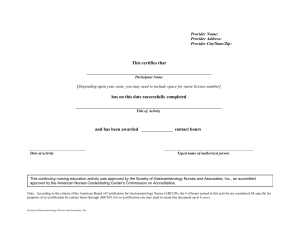Roslyn Pruitt: Nursing in the Storm
advertisement

I recently read, Nursing in the Storm: Voices from Hurricane Katrina by Denise Danna and Sandra Cordray. The book, released in late December 2009, is the first collective account from nurses on the front lines in New Orleans hospitals significantly impacted by flooding following Hurricane Katrina that made landfall on August 29, 2005. It is the authors’ hope we all learn from the nurses’ experience. When the New Orleans levee system failed, it left over 80 percent of the city under water within a day after the hurricane. The disaster claimed an estimated 1,700 lives, displaced a million people, and cost well over $100 billion. Six New Orleans area hospitals surrounded by floodwaters are featured in the book. They represent three groups of sister hospitals: Medical Center of Louisiana at New Orleans (Charity and University Hospitals); Lindy Boggs Medical Center and Memorial Medical Center; Pendleton Memorial Methodist Hospital and Chalmette Medical Center. Author Sandra Cordray, MA, MJ, states, “We felt it was important to hear from those nurses so that all of us can learn from their experience.” Adds Denise Danna, DNS, RN “There are several lessons from the Katrina experience. Since 2005 there has been legislation enacted by the state of Louisiana; a policy paper developed by the American Nurses Association; standards and policies created by regulatory and accreditation agencies to ensure all health care organizations and professional, city and state stakeholders -- all are in a state of readiness for any disaster -man-made or natural.” The nurses profiled in the book, far from hand maidens or shrinking violets, reminded me of my favorite nurse of all time, Mary Ann Bickerdyke, the “Cyclone in Calico.” I contacted Roslyn Pruitt, RN the Director of Clinical Quality Improvement at NorthShore Regional Medical Center (which was sold April 1, 2010) in Slidell, La. During Katrina she worked at Lindy Boggs Medical Center as the Hospital Compliance Officer. She was responsible for implementation of the Corporate Compliance Program at the hospital located in Mid-City New Orleans. Roslyn has worked in emergency medical services and hospital environments. She became a nurse assistant in 1975 and enrolled in the first emergency medical technician class in California in 1976. She has been a health facility surveyor for Center for Medicare and Medicaid Services in California and Louisiana. In the ‘80’s she received training in The Incident Command System which premiered in California. She has served on several disasters from the field, government, and hospital sides. In ‘92 she became a mobile intensive care nurse and worked for the federal government as a surveyor of nursing homes, hospitals and ambulatory services. She joined the staff at Lindy Boggs in 2004. Saturday night August 27, two days before Katrina made land fall, Roslyn’s “spidey sense” was tingling. Her husband was director of environmental services at Memorial Medical Center, located less than 5 miles from Lindy Boggs and its sister facility. Lindy Boggs had a nearly full patient census of 120, with over 800 people in the hospital. Although six physicians came to the hospital to work, others were no-shows. Seven hospice patients, in addition to many long-term acute care hospital patients, were ventilator dependent. The chief nursing officer tried very hard to evacuate patients before the storm, but no one could help them by this time as the mass exodus and evacuation was overwhelming the system. Roslyn realized Louisiana was 20 years behind and lacked mobile intensive care nurses. Roslyn recalls very poor communication between the hospital and EMS. Rumors are plenty, but information is scarce. EMS needed to communicate what was going on in the field. Nurses needed some control as EMS continued to deliver patients to the hospital. Roslyn strongly encouraged family members to leave before the storm reached land, informing them the hospital cannot provide anything for them or their animals. She does not know where they're going to sleep. Although flooding was a major concern for the neighborhood surrounding the hospital, the hospital had one boat, The Mercy. As Katrina makes landfall, shingles and rocks become projectiles. To this day, Roslyn would like to meet the person who decided hospitals should have flat, gravel covered roofs. She found herself the Incident Commander with no power and 800 people remaining. The staff recruits volunteers from among the remaining family and visitors. Temperatures reached over 100°. People exposed to the floodwater begin showing signs of infection eight hours later. Infection control measures are implemented. Anyone with nausea, vomiting, diarrhea, and fever is immediately isolated. Roslyn survived on energy bars and bottle water. Nine dialysis patients were placed on limited fluids and food. When a resident suggests using candles as a light source, Roslyn confiscates all the candles. Two days after the storm rescue firefighters are incredulous to discover patients and staff remain and question if the facility is a hospital. Roslyn is asked how many do not resuscitate orders there are. Roslyn realizes the firefighters were confusing DNR with comfort care and states developing standard terms is essential. Many of the nurses were not familiar with field triage and were upset when ambulatory patients were evacuated first, leaving the most critically ill behind. As they ran out of triage tags to attach to the patients, they began marking the patient's forehead, indicating if the patient is ambulatory or critical. They place a summary of the patient's medical chart by each patient along with a small plastic containing list and a three day supply of medications so that anyone with a glass of water could administer. Even as they evacuate patients, officials question why patients are there and emergency workers are ordered out due to the danger, leaving the nurses and patients. When a friend of one of the nurses becomes disruptive Roslyn instructs him to leave the premises. “I don’t care how you get out of here. Security, you escort him out the door and put him in the water if you need to, but he's not going to endanger our staff.”





